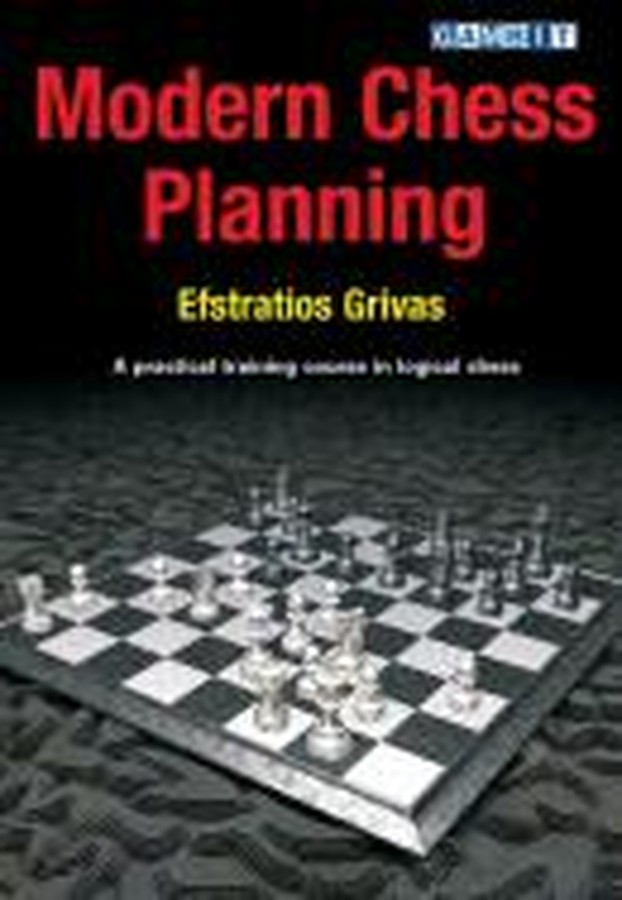| Nivå | C-D |
| Utgivelsesdato | April 2007 |
| Forfatter | |
| Pris | 220 NOK |
Modern Chess Planning
A practical training course in logical chessStormester Grivas serverer en bok om noe så vitalt som moderne planlegging i sjakk. Her er 75 stillinger, 50 av dem fra Grivas sine egne partier og 25 andre.
For hver av dem har Grivas formulert en stillingsbedømmelse og deretter tre nærliggende, alternative planer (A, B og C) som leseren skal velge blant. De fleste er midtspillstillinger, men her finnes også helt fra sjuende trekk i åpningen til enkelte strategiske sluttspill.
Bak i boka blir løsningsalternativene gjennomgått, i særdeleshet den riktige. Du får poeng for løsningene som du selv velger og kan dermed kvalifisere deg til en rating et sted mellom 1000 (bare feil løsninger) og 2750 (bare riktige).
Grivas skriver at boka passer best for spillere med ratingstyrke 1500 - 2200. Vi vil tilføye at stillingene er ganske krevende og ikke minst alternativene mer jevnbyrdige enn du ellers finner i en slik bok, så her er det noen fine vurderinger som selv elitespillere vil ha nytte av.
Forfatterens egen innledning:
Good planning is central to good chess. A plan gives meaning to manoeuvres and tactical devices, forming a coherent whole that brings us closer to our goals. The modern understanding of chess planning has evolved considerably since the days of the "grand plan", whereby a player might even try to map out the whole course of the game. Nowadays, top-class players appreciate that the opponent's ideas also deserve respect, and our own plans must take them into account too. Modern grandmasters plan with great purpose but also flexibly, ready to adjust or even change direction completely when the situation demands it.
Grivas provides 75 superb practical examples where it is important to make the right plan. Once the critical position is reached, he guides you through the options and challenges you to find the right path. Detailed solutions are provided, with a full discussion of the pros and cons of the various options.
Grandmaster Efstratios Grivas lives in Athens and is also an International Arbiter and Organizer. He has represented his country on a great many occasions, winning an individual gold medal at the 1989 European Team Championship and an individual silver medal at the 1998 Olympiad. He is a FIDE Senior Trainer and an experienced writer. This is his sixth book for Gambit.
Introduction
This book offers training on a vital subject, the choice of the best available plan.
As is commonly accepted in the chess world, a correct evaluation of the position, a strong plan and an accurate execution are the three important factors that separate 'the man from the boy'. In a way, efficient training on the three above-mentioned concepts can help a chess-player mature and lead him to new successful paths.
With this book I have sought to provide a training guide that will be helpful mostly to players in the 1500-2200 range - corresponding to lower club level up to those with aspirations for a FIDE title. Of course, the book may well also be useful for players weaker than 1500, or for those stronger than 2200, but this is a decision these players should make for themselves!
Before we go on, I have to say that I do not really believe in ratings. I also find the entire paranoia that revolves around them pretty much irrelevant. The rating system is supposed to reflect a player's results during a specific period of time in the past. This has nothing to do with his future development and thus we should consider the rating scale as a tool of statistical value. What really counts is winning important tournaments and championships. Only this can guarantee a chessplayer his place in chess history. People remember great chess-players not because of their ratings, but because of their outstanding achievements.
But anyway, this is a book for training purposes and assessing the reader's approximate chess strength. It is essential to determine this strength, for knowing exactly where we stand and what we need to improve, in other words knowing ourselves, is a very serious step towards improving our chess skills.
The reader may wonder why most of the games in this book (50 out of 75) are mine. Well, this is a good question and has a good answer: I have been a 'part' of these games, as I played them, and I can present my thoughts during and after them. This is an important factor. It would be perhaps easier for an author to present well-known games played by top GMs. However, although that has the benefit of providing welcome variety, it is hard in such cases to know exactly what was going through the minds of the players, unless they have provided unusually revealing annotations. I have therefore opted for a combined approach: 50 examples from my practice and 25 of other, outstanding players.
How this Book Works
In this book there are 75 tests, each based around a game. The first 50 games are mine and are presented in chronological order, so the reader may detect a progression in my play. Starting from 1984 (the year in which I achieved the IM title), there is at least one game from each year, until the present day. The other 25 games come from my personal archives and are games that I really love and respect.
In each of these tests, the starting point is the first diagram. There is a judgement (evaluation) of the diagrammed position, which helps the reader to understand some important facts about the position itself. A presentation of three possible plans follows. Then the reader must judge which is the most valuable plan. The best plan receives a maximum of 20 or 30 points. The other, less good, plans normally receive some points, depending on their actual value. Some of the plans receive no points at all; they are just bad!
After finishing work on the 75 tests, the reader must take a good look at the solutions, where he can find the answers to each. In the solutions, the game is analysed until its end, so the reader can better understand why the rewarded plan was the best in the position and how it worked out. In most cases, not much attention is paid to the inferior plans, as I think it is more important to examine and understand how the best plan suited the position. There are a few examples where the best available plan was overlooked, but still these are exceptions and the games were nevertheless quite interesting.
By this point, you will have received some very good training. But then, it will do no harm to measure your strength on this subject. The starting point will be 1000 rating points, to which you should add the total number of points awarded to your choices in the tests. The maximum is 1750 points (50x20 and 25x30), so a perfectly-scoring reader could reach up to 2750 rating points, a top-level GM's strength.
As one might notice from the table on page 141, expectations are a little higher than usual for the categories listed, as in this book the judgement of the position is given by the author beforehand, and this is a great help for the reader. A correct evaluation of any position is one of the most significant factors in chess, but that could be the subject for another book.
It must be mentioned that, before the games/tests, there is a short chapter, explaining why plans are so important in a chess game.
It is now time for you to train on that important chess concept, the plan. Have fun and train well!
| Innbundet? | Nei |
| Type | Bok |
| Språk | Engelsk |
| Antall sider | 143 |

